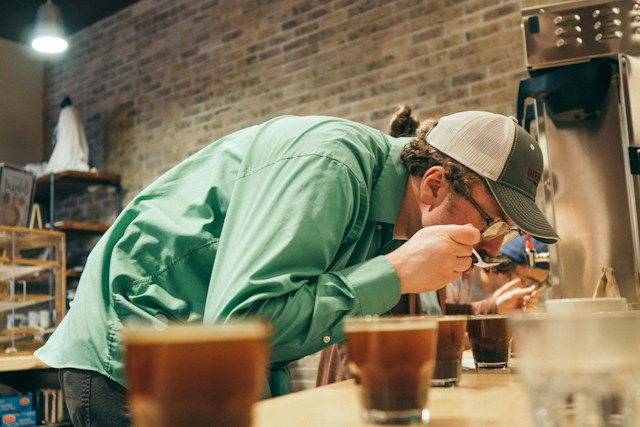Are you keen to dive into the world of coffee flavors but not sure where to start? Well, you’re in for an exciting journey. Coffee tasting, much like wine tasting, is an art that uncovers the depth and variety in your cup. Let’s explore this together in a simple, friendly way.

1. Coffee Origins and Their Impact on Flavor
Coffee flavors are deeply influenced by where the beans are grown. The climate, soil, and altitude all play a role.
- African Coffees: Often known for their fruity and floral notes. If you try a coffee from Ethiopia, you might detect hints of berries or citrus.
- Latin American Coffees: These generally have a brighter acidity and a clean taste. Think of a Colombian coffee with its nutty, chocolate tones.
- Asian Coffees: They tend to be earthier and fuller-bodied. A classic example is Sumatran coffee, known for its rich, spicy notes.
2. The Roasting Process
Roasting transforms green coffee beans into the aromatic brown beans we know. The roast level can significantly change the flavor.
- Light Roasts: They retain most of the bean’s original flavor, which is influenced by the bean’s origin. You’ll often find these to be more acidic and brighter.
- Medium Roasts: These offer a balance between acidity and body, bringing out a fuller flavor.
- Dark Roasts: Here, the roasting process starts to dominate the flavor, often resulting in a bitter, smoky taste.
3. The Grind and Brew Method
How you grind and brew your coffee also affects the flavor.
- Fine Grinds: Ideal for espresso, extracting a lot of flavors quickly.
- Coarse Grinds: Best for French press or cold brew, allowing a slower extraction and less bitterness.
Different brewing methods can highlight various aspects of coffee flavor. An AeroPress, for instance, can enhance the body and richness, while pour-over methods can bring out clarity and complexity.
4. Tasting Like a Pro: Coffee Cupping
Coffee cupping is the professional way of tasting and evaluating coffee. Here’s a simplified way you can try it at home:
- Grind the coffee to a medium-coarse texture.
- Add hot water and let it steep for about 4 minutes.
- Break the crust that forms on top with a spoon and smell the aroma.
- After the coffee cools a bit, take a spoonful, slurp it (yes, slurp! It helps to spread the coffee across your palate), and note the flavors.
5. Understanding Tasting Notes
Tasting notes can be overwhelming at first. Here’s a simple breakdown:
- Acidity: This isn’t about sourness, but more about a vibrant quality. Think about the difference between a lemon (high acidity) and a watermelon (low acidity).
- Sweetness: Good coffee should have a natural sweetness. It can range from sugary to fruity.
- Body: This is about how the coffee feels in your mouth. Is it light and refreshing or thick and rich?
- Flavor: This is the heart of tasting. Do you taste nuts, chocolate, fruits, spices?
6. Personal Preference and Experimentation
Remember, coffee tasting is subjective. What matters most is what you enjoy. Don’t be afraid to experiment with different beans, roasts, and brewing methods. Each variation can bring a new and exciting flavor profile.
7. Keeping Notes
Just like a journal, keeping notes on your coffee tasting can enhance your understanding and appreciation. Note down the type of coffee, brewing method, flavors, and your personal rating.
8. Pairing with Food
Coffee can be paired with food to enhance its flavor. For example, a light roast with a citrus flavor profile pairs beautifully with berry pastries, while a dark roast goes well with chocolate.
9. The Role of Water
The quality of water used in brewing greatly affects the taste of the coffee. Soft water tends to highlight acidity, while hard water can emphasize bitterness.
Conclusion
Embarking on a coffee tasting journey is a delightful experience that awakens your senses to the rich and varied world of coffee. It’s about discovery, one cup at a time. As you explore, you’ll not only deepen your appreciation for coffee but also find your unique preferences. So grab a cup, take a sip, and savor the journey. Happy coffee tasting!

Leave a Reply